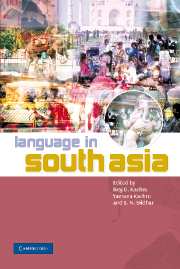Book contents
- Frontmatter
- Contents
- List of Figures
- List of Maps
- List of Tables
- Preface
- Acknowledgments
- List of Abbreviations
- Note on Transcription
- Introduction: languages, contexts, and constructs
- Part 1 Language history, families, and typology
- Part 2 Languages and their functions
- Part 3 Sanskrit and traditions of language study
- Part 4 Multilingualism, contact, and convergence
- Part 5 Orality, literacy, and writing systems
- Part 6 Language conflicts
- Part 7 Language and modernization
- Part 8 Language and discourse
- 17 Language in social and ethnic interaction
- 18 Language and the legal system
- 19 Language in the media and advertising
- 20 Language in cinema
- 21 Language of religion
- Part 9 Language and identity
- Part 10 Languages in diaspora
- References
- Subject Index
- Language Index
- Author Index
21 - Language of religion
Published online by Cambridge University Press: 04 May 2010
- Frontmatter
- Contents
- List of Figures
- List of Maps
- List of Tables
- Preface
- Acknowledgments
- List of Abbreviations
- Note on Transcription
- Introduction: languages, contexts, and constructs
- Part 1 Language history, families, and typology
- Part 2 Languages and their functions
- Part 3 Sanskrit and traditions of language study
- Part 4 Multilingualism, contact, and convergence
- Part 5 Orality, literacy, and writing systems
- Part 6 Language conflicts
- Part 7 Language and modernization
- Part 8 Language and discourse
- 17 Language in social and ethnic interaction
- 18 Language and the legal system
- 19 Language in the media and advertising
- 20 Language in cinema
- 21 Language of religion
- Part 9 Language and identity
- Part 10 Languages in diaspora
- References
- Subject Index
- Language Index
- Author Index
Summary
Introduction
In South Asia including Tibet, the indigenous religions, Hinduism, Buddhism, Sikhism, and Jainism, and the extraneous religions, Islam, Christianity, Judaism, and Zoroastrianism, currently coexist with various tribal religious systems. One of the striking features of the language of religion in this region is that there is no fixed equation of one linguistic form with one religion. Many languages are used to express one religion and one language is used to express many religions. For example, Christianity is expressed through English (in India, Pakistan, Bangladesh, and Sri Lanka), Portuguese/Konkani (in Goa), Tamil (in Tamil Nadu), Hindi (in India), Sinhala (in Sri Lanka), Urdu (in Pakistan), and Bengali (in West Bengal and Bangladesh). Similarly, Hindi is used to express not only Hinduism, but also Buddhism, Christianity, and Jainism. Within the same religious community, diverse languages are used to perform different religious functions, thereby producing a diglossic situation. For example, Sanskrit is used for major rituals of Hinduism, while for household rituals, modern Indian languages are used. Adding to this variation are various registers of regional religious languages such as Sanskritized, Arabicized, Persianized Hindi, Marathi, and so forth.
The emergence, sustenance, and change in the patterns of variation in the use of linguistic codes (languages or language varieties) for expressing religions in South Asia has not been systematically and adequately studied. There are individual studies that explain the variation based on the historical events.
- Type
- Chapter
- Information
- Language in South Asia , pp. 407 - 426Publisher: Cambridge University PressPrint publication year: 2008
- 4
- Cited by



